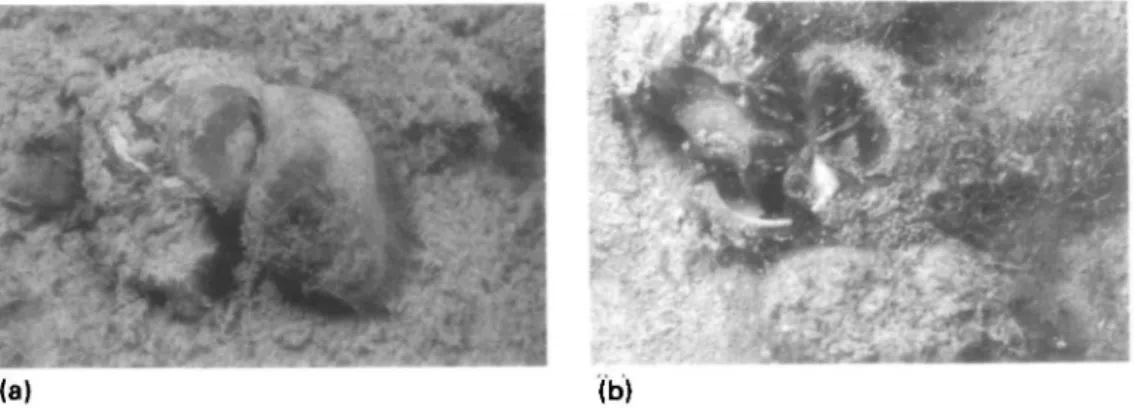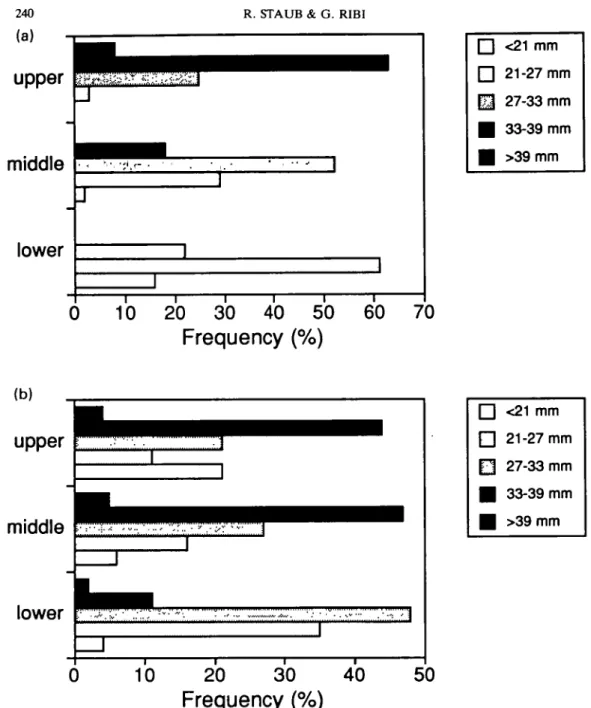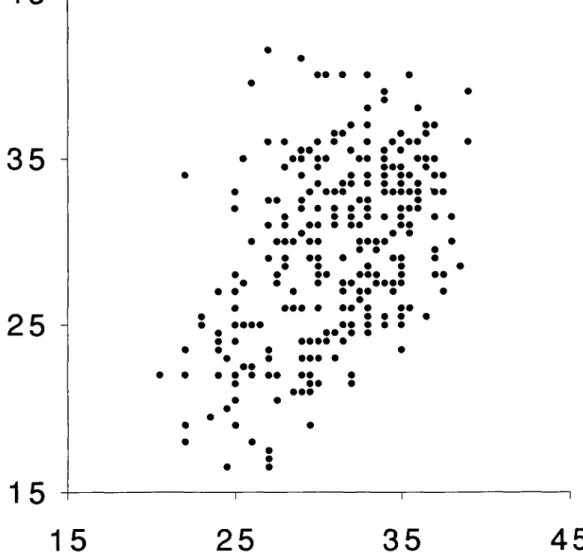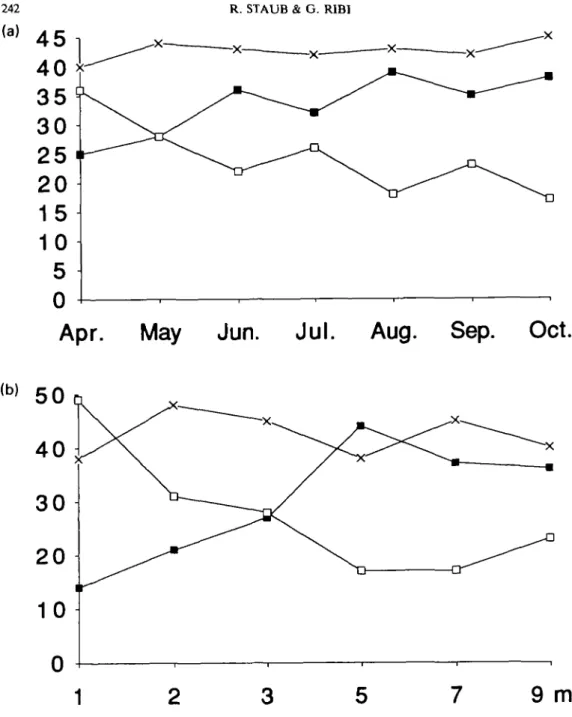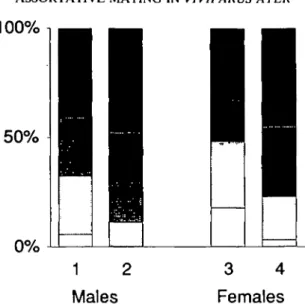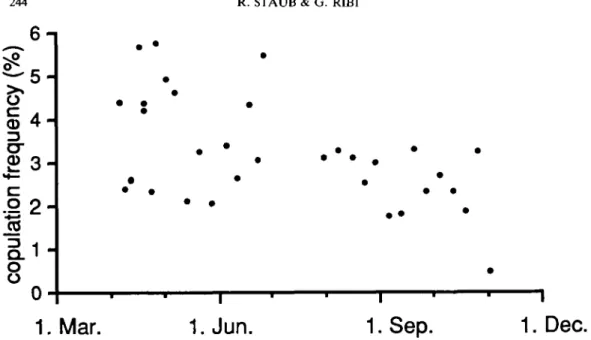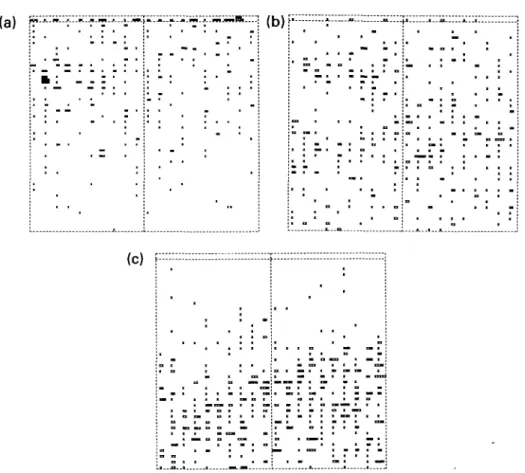J. Moll. Stud. (1995), 61,237-247 © The Malacological Society of London 1995
SIZE-ASSORTATIVE MATING IN A NATURAL POPULATION
OF VIVIPARUS ATER (GASTROPODA: PROSOBRANCHIA)
IN LAKE ZURICH, SWITZERLAND
R. STAUB and G. RIBIZoologisches Museum der Universittit Zurich, Winterthurerstrasse 190, 8057 Zurich, Switzerland (Received 29 January 1993; accepted 14 November 1994)
ABSTRACT
The number of mating pairs, the size of the mating partners, and the distribution of individuals of Vivi-parus ater on a grid in Lake Zurich were recorded during one breeding season in 1990. There was posi-tive assortaposi-tive mating with respect to shell size. The proportion of copulating individuals ranged from 1% to 6% (average 3%) of the active population at any one time. Individual snails copulated 60 times on average from April until November. Snails were abundant and copulated in shallow water close to the shore in Spring. They moved towards deeper areas in Autumn. V. ater copulated on all substrates at any depth (1-9 m) of the grid. The spatial distribution of copulations throughout the summer reflected the pattern of snail abundance.
INTRODUCTION
Mating frequency and the distribution of matings
in time vary widely among species. Mating
patterns have been interpreted as an adaptation
to specific ecological conditions (Constantz,
1984), or to a small effective population size
(Murray, 1964), or as a result of conflicting
interests of males and females (Leonard &
Lukowiak, 1984; Trivers, 1985; Ward, Hemmi
& Roosli, 1992).
Males may increase their fitness by increasing
the number of matings or the amount of sperm
transferred to females relative to other males
(Trivers, 1972), or by an optimal timing of
copulations with respect to female receptivity
(Cheng & Burns, 1988; Drickamer, 1992). For
females, optimizing the number of copulations
is less straightforward, because the number of
eggs a female can produce is limited. After the
fertilization of the available eggs is ensured, the
cost of additional copulations may exceed
possible benefits. Costs of copulations include
interference with other activities such as
feed-ing (copulations in gastropods may last up to 36
hours; Lind, 1988; Tischler, 1973), a higher
predation risk (Simmons, 1986; Pollard, 1975),
physical damage by the act of copulation itself
(Ward, Hemmi & Roosli, 1992), and parasite
infection (Armstrong, 1977; Morand, 1988).
Possible benefits of surplus copulations are the
chance of finding better quality sperm
(Curt-singer, 1991), the possibility of increasing the
genetic variation of a clutch by using sperm of
different males (Williams, 1975), or gaining
additional resources from the ejaculate (Boggs
& Gilbert, 1979).
Viviparids are live-bearing freshwater
pro-sobranch snails. The sexes are separate. In V.
ater (Cristofori & Jan), females kept without
males did not reproduce (Trtib, 1990). In
con-trast to other Viviparus species (Browne, 1978;
Stanczykowska, Magnin & Dumouchel, 1971),
females of V. ater do not grow older or larger
than males. Both sexes can live for ten years or
more (Ribi, Mutzner & Gebhardt, 1986) and
grow to approximately 45 mm in shell height. In
Lake Zurich, female V. ater maintain a similar
age-specific fecundity of approximately 9 female
offspring per year between 2 and 6 years of age
(Ribi, 1986). The offspring are born 6-11 mm in
shell diameter after a gestation time of 3 to 9
months.
Males of the genus Viviparus produce two
types of sperm, eupyrene and oligopyrene
(Siebold, 1836). Oligopyrene sperm are infertile
but rich in polysaccharides (Hanson, Randall
& Bayley, 1952). In V. contectus (Millet) they
are absorbed by females, and may be invested
in offspring (Dembski, 1968). We assume that
this also applies to V. ater. If males were to
make a significant energetic contribution to a
female's reproductive output by providing
sperm, one would expect copulations to be
frequent. Frequent mating is, however, not
essential for successful reproduction in V. ater.
In a breeding experiment using caged snails,
mated females continued to release offspring
for two years after they had been isolated (Trilb, 1990).
Size-assortative mating is expected to occur if males compete for females and if larger females have a higher fecundity than smaller ones (Ridley, 1983). Random mating with respect to size is expected if the encounter rate between potential mates is low (Parker, 1983). In V. ater, larger females produce more offspring than smaller ones (Ribi & Gebhardt, 1986), and encounter rates are reasonably high as inferred from multiple matings of marked individuals in nature (Ribi & Arter, 1986) and from the high population densities observed at many places (Barbato, 1971; De Bernardi, Ravera & Oregioni, 1976; Triib, 1990). There-fore we expect that males should prefer large females because of higher fecundity, and females should prefer large males if their ejacu-late contains more energy than that of smaller males. The expected preferences by males and females may result in positive assortative mating by size, which we call size-assortative mating.
In this study we recorded the mating activity and the population density of Vivparus ater in Lake Zurich in Summer 1990. We asked the following questions:
1. Is there evidence of size-assortative mating? 2. How often do V. ater copulate in nature? 3. How are copulations distributed in time and
space?
METHODS
A grid of 40 by 42 m (totalling 1680 m2) ranging from
the shore to 9 m depth was set out near Goldbach, Lake Zurich, at the end of March 1990. The shore
line consisted of large blocks of stone. The lake-bed in the shallow part of the grid consisted of gravel and stones, in the deeper part it consisted of sand and mud. The grid was at the same location as a previous one which was used to estimate offspring survival (Keller & Ribi, 1993).
The grid was searched for copulating pairs of V. ater by two Scuba divers once a week from 4 April until 9 November 1990, with the exception of a break of three weeks starting on 23rd June. A pair was recorded copulating if one snail was observed holding on to another (Fig. la), or if the penis was observed to be introduced into the partners mantle cavity (Fig. lb).
For each pair encountered, the location on the grid and the size class (<=21, 22-27, 28-33, 34-39, >=40mm shell height) of the male and the female was recorded. The size classes were based on a size-age survey made near Kilsnacht (some 2 km from the study site) during 1987/88, which showed that an age structure could be assigned to each size class (Fig. 2). The size class was determined by holding a calibrated stick next to each snail, to avoid disturbance of copu-lating pairs (data set 1, N = 1136). From August until November, in addition to being scored using the cali-brated stick, the snails of 308 pairs were separated and measured to the nearst half mm using sliding calipers (data set 2). The first data set can show spatial differences or seasonal changes of the mating pattern, while the second set provides more accurate data on the relative size of mating partners. A com-parison of the two data sets revealed that the assign-ment to a size class using the calibrated stick was correct in 83% of cases. There was an overestimation of size in 15% and an underestimation in 2% of the cases. Of the first 184 pairs encountered, the substrate type (hard or soft) was also recorded.
Dives were carried out in the morning between 0900 and 1200 h. On three days in April-May and on three days in September, an additional dive was per-formed in the afternoon of the same day. On those days, a metal stick was put into the sediment next to each copulating pair in the morning to avoid counting
(b)
Figure 1. Copulations of Viviparus ater in nature, a) A male (right) holding on to a female; this is the most frequent mating position, b) Open position: the female is lying on the ground with the aperture of the shell exposed. The male has the penis introduced into the mantle cavity.
ASSORTATIVE MATING IN VMPARUS ATER 239
100%
50%
0%
<22 24.5 30.5 36.5 >39mm
Figure 2. Age frequency distributions of Viviparus ater near KQsnacht, Lake Zurich, of the five size classes (labelled as upper or lower end or midpoints) used to estimate the sizes of mating partners. Left bars = males (N=1468), right bars = females (N=1475); white=0+, grey=l + , black= 2 years and older.
the same pair twice and to obtain a rough estimate of copulation duration. Any pair recorded near a marker stick in the afternoon was assumed to be the same pair as that recorded in the morning. Dembsky, (1968) found that the average duration of copulation in V. contectus was 2l/i hours, hence the chances of
finding a different pair at the same place on the same day were low.
To obtain an estimate of the number of active snails on the grid throughout the study period, the snails were counted on every second row (parallel to the shore) of grid units on each dive, and the total number of snails counted multiplied by a factor of 2. Thermometers were installed at 1.5, 3, 5.5, 7, and 8.5 m depths and the temperatures recorded during each dive.
The average number of copulations (C) per in-dividual in one breeding season can be estimated by the formula C = (a 1 p)/d, where (a) is the daily period during which copulations may occur, measured in hours; (d) is the average duration of copulation measured in hours; (1) is the length of the breeding season measured in days; and (p) is the proportion of copulating snails observed at any one time. In a mating experiment in small artificial ponds using both V. ater and V. contectus, copulations occurred during 24 hours per day in both species. V. ater showed no consistent difference in mating frequency between day and night (Ribi, unpublished data). Hence we assume that the daily period during which copulations may occur (a) is 24 hours in natural populations of V.
ater. The mating experiments in artificial ponds gave no indication that the duration of copulation is dif-ferent between V. ater and V. contectus. We therefore use 2.5 hours, as observed by Dembski (1968) for V. contectus, as an average copulation duration for V. ater. In Lake Zurich, the breeding season of V. ater is from early April until late October (Burla, 1972), resulting in a breeding season (1) of approximately 210 days. The proportion (p) of copulating snails observed at any one time was calculated by dividing the number of copulating snails by the total number of visible snails on the grid for each dive.
The data concerning the size of mating partners were analysed by linear regressions using the SAS program package (SAS Institute Inc., 1989). Because the size frequency distributions of V. ater were not the same in different depth zones (Fig. 3), a positive correlation of the sizes of mating partners could have arisen from the spatial zonation of snails of different sizes rather than as a consequence of size assortative mating. A second bias could have been introduced by vertical migrations of the snails (Table 1, Fig. 3). In order to remove the effects of the location on the grid and the time of the year, a multivariate regression was performed on each data set with the sizes of the two partners of a mating pair as the dependent vari-ables and the two grid axes and the date of obser-vation as independent variables. The residuals of the sizes of the two partners were then plotted against each other and analysed by linear regression.
RESULTS 1. Size-assortative mating
We have two data sets with regard to the shell size of mating pairs, i.e. one in which five size classes (class width 6 mm) were recorded, from April until November (data set 1), and one in which the snails were measured to the nearest half mm, from August until November (data set 2).
A significant positive correlation between the sizes of copulating individuals can indicate size-assortative mating (Ridley, 1983). In both data sets there were significant positive correlations between the sizes of mating partners (Fig. 4), and also between their residuals after the effects of the location on the grid and of the Table 1. Spatial and temporal pattern of the average density (ind m 2) of Viviparus ater on the grid in Summer 1990.
Boulder-zone 1-3 m 3-5 m 5-7 m 7-9 m April 0.52 0.57 0.59 0.28 0.22 May 6.00 1.74 1.14 1.39 1.46 June 2.11 1.21 0.69 0.65 1.33 July 0.39 1.23 1.10 1.37 1.43 Aug. 0.52 1.99 2.16 3.03 2.12 Sept 0.20 1.32 2.63 4.80 3.73 Oct. 0.17 0.46 3.27 3.27 3.39
la;
upper
middle
lower
wmmmmMmmt
j
j
i
i
• •— Ij
i i ii
I•
•
•
<21 mm
21-27 mm
27-33 mm
33-39 mm
>39 mm
0 10 20 30 40 50 60
Frequency (%)
70
(b)
upper
middle
lower
•
•
•
•
<21 mm
21-27 mm
27-33 mm
33-39 mm
>39 mm
0
20 30
Frequency (%)
Figure 3. Size frequency distribution of Viviparus ater in the upper (1-3 m depth), middle (4-6m), and lower (7-9 m) part of the grid in June (a) and August (b) 1990.
observation date had been removed (Table 2).
In data set 1, the frequency of pairs in which
both partners belonged to the same size class
was between 40 and 45% at all times and all
depth zones (Fig. 5). Pairs with larger females
were more frequent than pairs with larger males
in April (Fig. 5a) and in the upper third of the
grid (Fig. 5b), while pairs with larger males
outnumbered pairs with larger females from
June until October and on the lower half of
the grid. In data set 2, pairs with larger males
(n=99; difference>3mm) were twice as
fre-quent as pairs with larger females (n=42). This
may reflect the fact that small males never
ASSORT ATI VE MATING IN VIVIPARUS ATER 241
45
35
25
15
• •
15
25
35
45
Figure 4. Shell height in mm of the partners of 308 mating pairs of Viviparus aler observed on the grid from August until November 1990. Males on x-axis, females on y-axis.
Table 2. Linear regression of the residuals of the
sizes of the two partners of a mating pair. The residuals were generated by multivariate regres-sion on the sizes of the mating partners, with the vertical (depth) and the horizontal grid axes, and the date of observation as independent variables.
N Sum of squares F P
Model Error
Data set 1 1136 83.45 459.57 205.2 0.0001 Data set 2 308 1042.20 3663.94 87.0 0.0001
mated, while small females did (Fig. 6). Whether
this should be interpreted as mate preference of
females for larger males depends on the mating
capability of small males. In the laboratory,
23mm males were observed to mate. There
were, however, no larger snails in the tank.
A wide range of size combinations of males
and females was observed (Fig. 4), indicating
that size assortative mating in V. ater is not due
to physical incompatibility between partners of
unequal size.
In both males and females of data set 1,
smaller snails (size classes 0 and 1 = snails
(a)
Apr. May Jun. Jul. Aug. Sep. Oct.
1
9 m
Figure 5. Percentage of copulating pairs with larger males (black symbols), larger females (open symbols), and pairs in which both partners belong to the same size class (— x—), from April until October 1990 (a), and from the shore to 9 m depth (b).
smaller than 28 mm) were observed copulating
less often than expected from their relative
frequency in the population observed in a
pre-vious study (Chi = 318 for males and 271 for
females, DF=1, p < 0.0001 in both cases; Fig.
6). This can be interpreted in two ways. Smaller
(younger) snails may mate less often on
average, or their copulation duration may be
shorter, reducing the probability of being
de-tected by a diver. A shorter copulation duration
of young as opposed to older adults has been
reported for Achatina fulica (Tomiyama, 1994).
ASSORTATTVE MATING IN VIV1PARUS ATER
100%
24350%
0%
1 ;
Males
Females
Figure 6. Proportions of five different size classes (<=21, 22-27, 28-33, 34-39, >=40mm shell height; from white to black) of Viviparus ater in the population as reported by Keller & Ribi, 1993 (bars 1 and 3), and in copulating pairs (bars 2 and 4), for males and females.
2. Mating frequency
V. ater copulated throughout their active period
from April until early November. The
propor-tion of copulating individuals ranged from 1 to
6% (average 3%) of the active part of the
population (i.e. the snails that are not buried in
the sediment). It was highest in April and
declined thereafter (Fig. 7). There was a
positive linear relationship between the number
of copulations and the number of snails observed
(R
2= 0.975). The average copulation frequency
per snail was 60.5 copulations per breeding
season or one copulation every 3.47 days.
3. Distribution of copulations in time and space
Fig. 8 shows the spatial distribution of
copu-lations. In April-May the majority of pairs were
observed in the upper half of the grid. From
June until August copulations were scattered
over the entire area of the grid, while in
September-October most copulations occurred
in the lower half. This pattern reflects the
sea-sonal distribution of the snails on the grid
(Table 1), indicating that snails copulate in all
parts of the grid during a breeding season.
Copulations were observed on every substrate
type present on the grid. Twenty five per-cent
of the first 184 pairs were recorded on stones,
the remaining 75% on mud. This was equivalent
to the estimated proportions of hard and soft
bottom available in the upper part of the grid,
where the majority of these pairs were
encoun-tered. Hence the snails seem to mate
indis-criminately with respect to substrate type.
The proportion of copulating snails was
simi-lar in the morning and in the afternoon in
April-May, and slightly but not significantly (p=0.13,
paired t-test, df=2, t=2.50) higher in the
after-noon in September (Table 3). The average
duration of copulation decreased from Spring
to Autumn. In April, approximately one third
of the copulating pairs were still in copula after
5 hours. By September, this figure had dropped
to 7% (Chi*=4.5, DF=1, p=0.033). The
decrease in copulation duration was
accom-panied by a rise in water temperature from 8°C
in April to 19°C in September.
Evidence for seasonal migration comes from
the local population densities and the size
fre-quency distributions. The highest local densities
were recorded in the near shore area in May
and between 5 and 7 m depth in September
(Table 1). The size frequency distributions in
three depth zones show an increase of the
pro-portion of larger snails at greater depths from
June to August (Fig. 3). This suggests that
larger snails participate in the seasonal
migra-tions towards deeper water in Autumn and
towards the shore in Spring, while smaller
(younger) snails tend to stay at greater depths
throughout the Summer. Since young snails
have a relatively thin shell, this behaviour may
be interpreted as predator avoidance (Keller &
Ribi, 1993).
R. STAUB & G. RIBI
| 4 H
0) o „
O O a 31-Q.
8
1. Mar.
1. Jun.
I.Sep.
1. Dec.
Figure 7. Frequency of copulations of Viviparus ater on the grid from 4 April to 11 November 1990, as the proportion of copulating snails to the number of snails observed on the grid.
Table 3. Copulation frequencies in the morning and afternoon, and
pro-portion of copulations which lasted for more than 5 hours (lasting copula-tions), on 3 days in April-May and on 3 days in September 1990. N = total number of copulations observed in the mornings of 3 days.
April/May September Proportion morning 3.4% 2.6% of copulating snails afternoon 3.2% 3.6% Lasting copulations 37% 7% N 43 93
DISCUSSION
1. Size-assortative mating
In gastropods, size-assortative mating has been
documented in opisthobranchs (Crozier, 1918)
and in prosobranchs (Edwards, 1968), while
random mating may prevail in land snails
(Baur, 1992). In the cowry Cypraea annulus, no
correlation was observed between the sizes of
mating males and females (Katoh, 1989).
V. ater can be considered a K-strategist
relative to other gastropod species with which
it may compete. It is larger, grows older, and
invests more into individual offspring than any
other gastropod living in Lake Zurich and
cen-tral Europe (Calow, 1978). Its life history data
are similar to those of vertebrate species in
which female mate choice has been
docu-mented (Trivers, 1972). With respect to
reproduction, quality seems to be more
impor-tant than quantity in V. ater. Therefore, mate
preference could be expected at least in
females.
With respect to assortative mating we have
made the following three observations which
need to be explained. (1) Significant size
assor-tative mating in both data sets; (2) both pairs
with larger males and pairs with larger females
occur frequently in nature; (3) pairs with larger
females were more abundant in Spring, pairs
with larger males were more abundant in
Summer and Fall. We can think of three possible
scenarios to explain these observations. (I)
Snails prefer to mate with similar sized
part-ners, possibly because of a good physical fit
ASSORTATIVE MATING IN VIVIPARUS ATER 245 I f) I ^ " - A. - ^ - - J
(b)
(c)
Li
-. -. ° ° = - — " ° . ° • —: ! ', z:Figure 8. Spatial distribution of copulations of Viviparus ater on a grid of 40 by 42 m, ranging from the shore (top) to 9 m depth, in April-May (a), in June-August (b) and in September-October (c), 1990.
which makes sperm transfer most efficient. (II)
Both sexes prefer to mate with larger partners,
because of an expected higher fitness return of
larger partners. (Ill) There is no mate
prefer-ence in V. ater. the size-assortative mating
pattern observed has reasons other than mate
preference. We now consider the plausibility of
each of the three scenarios.
Scenario I: Observation 1 (size assortative
mating) is consistent with Scenario I.
Obser-vations 2 to 3 weaken it, but are not
incon-sistent with it. They merely suggest that the
preference to mate with an equally sized
partner is not very strong.
Scenario II: Observation 1 (size assortative
mating) is consistent also with Scenario II.
Observation 2 (frequent occurrence of unequal
pairs) suggests that both sexes can be rather
opportunistic with respect to the size of the
partner. Observation 3 (pairs with larger
fe-males in Spring and larger fe-males in Autumn) is
consistent with Scenario II, if distribution
changes of the snails on the grid (large females
migrated downwards) are considered. Hence
observation 3 may in part reflect differences in
the size distributions of the sexes at different
depth zones at different times of the year.
Another explanation of observation 3 is that the
motivation to mate with a larger partner may
change over time, being higher for males in
Spring and higher for females in Autumn. The
two explanations are not mutually exclusive.
Scenario III: The significant size-assortative
mating pattern observed could have arisen by
local aggregation of similar sized individuals,
for which, however, there is no supporting
evidence.
In conclusion, we think that Scenario I or
Scenario II applies, meaning that there is mate
preference with respect to size in V. ater.
However, we do not know whether snails prefer
larger partners or partners of similar size, and
whether mate preference occurs in both sexes.
2. Mating frequency
Multiple matings may contribute to an increase
in fitness. In the land snail Arianta arbustorum
(L.), snails which were allowed to re-mate had
a higher fecundity than snails kept in isolation
after having mated once (Baur, 1988). A high
mating frequency may be typical for freshwater
snails. In V. contectus, females were observed
to mate with several males in one day
(Dembski, 1968). A high mating frequency may
be advantageous for females of Viviparus
because of the extra energy acquired from
sperm (Dembski, 1968). In Lymnaea auricularia
(L.) and L. ovata (Draparnaud, 1805), 134
copulation-groups comprising 301 individuals
(some groups consisted of more than 2
in-dividuals) were collected during 8 dives in Lake
Zurich (Burla & Speich, 1971), suggesting a
high mating frequency also in Lymnaea. The
high mating frequency of V. ater contrasts with
that of the land snail Helix pomatia L., which
was observed to mate only a few times during
a breeding season (Lind, 1988; Tischler, 1973).
3. Distribution of matings in space and time
Unlike in land snails, where mating is
asso-ciated with the risk of desiccation (Prior, 1985)
and predation (Pollard, 1975), the cost of
copu-lations in V. ater appears to be low. This is
reflected by the spatial and temporal
distri-bution of copulations: we observed V. ater
mating at any depth, on any substrate, at any
time. Thus there is no indication that copulating
individuals suffer higher predation rates than
single snails.
ACKNOWLEDGEMENTS
We thank H. Maag and the diving team of the
Zoological Museum for help with the field
work, H. Triib for suggestions concerning data
collection, A. Barbour and C. Rauter for help
with data analysis, and N.J. Evans, M. Katoh,
A.H. Porter, and P.H. Rudolph for comments
on the manuscript.
REFERENCES
ARMSTRONG, E. 1977. Transmission of Nosema kingi to offspring of Drosophila willistoni during copu-lation. Zeitschrift filr Parasitcnkunde, 53: 311-315.
BARBATO, G. 1971. Studio sul comportamento stagionale di Viviparus ater (Crist. & Jan) dei laghi d'Iseo e di Garda. Natura, 62: 65-74.
BAUR, B. 1992. Random mating by size in the simul-taneously hermaphroditic land snail Arianta arbus-torum: experiments and an explanation. Animal Behaviour, 43: 511-518.
BAUR, B. 1988. Repeated mating and female fecun-dity in the simultaneously hermaphroditic land snail Arianta arbustorum. Invertebrate Repro-duction and Development, 14: 197-204.
BOGGS, C.L. & GILBERT, L.E. 1979. Male
con-tribution to egg production in butterflies: evidence for transfer of nutrients at mating. Science, 206: 83-84.
BROWNE, R.A. 1978. Growth, mortality, fecundity, biomass and productivity of four lake populations of the prosobranch snail, Viviparus georgianus. Ecology, 59: 742-750.
BURJ_A, H. 1972. Die Abundanz von Anodonta, Unio pictorum, Viviparus ater, Lymnaea auricularia und Lymnaea ovata im Zurichsee, in AbhSngigkeit von der Wassertiefe und zu verschiedenen Jahres-zeiten. Vierteljahresschrift der naturforschenden Gesellschaft Zurich, 117: 129-151.
BURLA, H. & SPEICH, C. 1971. Lymnaea auricularia und Lymnaea ovata im ZOrichsee. Revue Suisse de Zoologie, 78: 549-556.
CALOW, P. 1978. The evolution of life-cycle strategies in fresh-water gastropods. Malacologia, 17: 351-364.
CHENG, K.M. & BURNS, J.T. 1988. Dominance
relationship and mating behavior of domestic cocks. A model to study mate-guarding and sperm competition in birds. Condor, 90: 697-704. CONSTANTZ, G.D. 1984. Sperm competition in
poe-ciliid fishes. In: Sperm competition and the evolu-tion of animal mating systems. R.L. Smith (ed.), 465-485. Academic Press, San Diego.
CROZIER, W.J. 1918. Assortative mating in a nudi-branch, Chromodoris zebra Heilprin. Journal of Experimental Zoology, T7: 247-292.
CURTSINGER, J.W. 1991. Sperm competition and the evolution of multiple mating. American Naturalist, 138: 93-102.
D E BERNARDI, R., RAVERA, O. & OREGIONI, B.
1976. Demographic structure and biometric characteristics of Viviparus ater Cristofori and Jan (Gasteropoda: Prosobranchia) from Lake Alserio (Northern Italy). Journal of Molluscan Studies, 42: 310-318.
DEMBSKI, W.J. 1968. Histochemische Unter-suchungen Uber Funktion und Verbleib eu- und oligopyrener Spermien von Viviparus contectus (Millet 1813). Zeitschrift filr Zellforschung, 89: 151-179.
DRICKAMER, L.C. 1992. Oestrous female house mice discriminate dominant from subordinate males and sons of dominant from sons of subordinate males by odour cues. Animal Behaviour, 43: 868-870.
EDWARDS, D.C. 1968. Reproduction in Olivella biplicata. Veliger, 10: 297-304.
ASSORTATTVE MATING IN VfVIPARUS ATER 247
HANSON, J., RANDALL, J.T. & BAYLEY, S.T. 1952.
The microstructure of the spermatozoa of the snail Viviparus. Experimental Cell Research, 3: 65-78. KATOH, M. 1989. Life history of the golden ring
cowry Cypraea annulus (Mollusca: Gastropoda) on Okinawa Island, Japan. Marine Biology, 101: 227-234.
KELLER, G. & RIBI, G. 1993. Fish predation and offspring survival in the prosobranch snail Vivi-parus ater. Oecologia, 93: 493-500.
LEONARD, J.L. & LUKOWIAX, K. 1984. Male-female
conflict in a simultaneous hermaphrodite resolved by sperm trading. American Naturalist, 124: 282-286.
LIND, H. 1988. The behaviour of Helix pomatia L. (Pulmonata, Gastropoda) in a natural habitat. Videnskabetige Meddelelser fra Dansk natur-historisk Forening i Khobenhavn, 147: 67-92. MORAND, S. 1988. The developmental cycle of
Nemhelix bakeri Morand and Petter (Nematoda, Cosmocercidae) parasite of the genital tract of Helix aspersa Mueller (Gastropoda, Helicidae). Canadian Journal of Zoology, 66: 1796-1802. MURRAY, J. 1964. Multiple mating and effective
population size in Cepaea nemoralis. Evolution, 18: 283-291.
PARKER, G.A. 1983. Mate quality and mating de-cisions. In: Mate Choice. P. Bateson (ed.), 141-164. Cambridge University Press, Cambridge.
POLLARD, E. 1975. Aspects of the ecology of Helix pomatia L. Journal of Animal Ecology, 44: 305-329.
PRIOR, D.J. 1985. Water regulatory behaviour in terrestrial gastropods. Biological Research, 60: 403-424.
RIBI, G. 1986. Within-lake dispersal of the proso-branch snails, Viviparus ater and Potamopyrgus jenkinsi. Oecologia, 69: 60-63.
RIBI, G. & ARTER, H. 1986. Sex related difference of movement speed in the freshwater snail Viviparus ater. Journal of Molluscan Studies, 52: 91-96. RIBI, G. & GEBHARDT, M. 1986. Age specific
fecun-dity and size of offspring in the prosobranch snail, Viviparus ater. Oecologia, 71: 18-24.
RIBI, G., MUTZNER, A. & GEBHARDT, M. 1986. Shell
dissolution and mortality in the freshwater snail Viviparus ater. Schweizerischc Zeitschrift fOr Hy-drologie, 48: 3443.
RIDLEY, M. 1983. The Explanation of organic diver-sity. Clarendon Press, Oxford.
SAS INSTITUTE INC., 1989. SAS/STAT User's Guide, Version 6, Fourth Edition, Volume 1, Cary, NC: SAS Institute Inc., 943 pp.
SIEBOLD, C.T. 1836. Fernere Beobachtungen Ober Spermatozoen der wirbellosen Thiere. 2. Die Spermatoztten der Paludina vivipara MUller. Archiv fiir Anatomic, Physiologie und Wissen-schaftliche Medizin, 2: 232-255.
SIMMONS, L.W. 1986. Female choice in the field cricket Gryllus bimaculatus. Animal Behaviour, 34: 1463-1470.
STANCZYKOWSKA, A., MAGNIN, E. & DUMOUCHEL,
A., 1971. Etude de trois populations de Viviparus malleatus (Reeve) (Gastropoda, Prosobranchia) de la region de Montreal. I. Croissance, ferondite, biomasse et production annuelle. Canadian Journal of Zoology, 49: 1431-1441.
TISCHLER, W. 1973. Zur Biologie und Oekologie der Weinbergschnecke {Helix pomatia). Faunistisch-dkologische Mitteilungen, 4: 283-298.
TOMIYAMA, K. 1994. Courtship behaviour of the giant African snail, Achatina fulica (F6russac) (Stylomatophora: Achatinidae) in the field. Journal of Molluscan Studies, 60: 47-54.
TRIVERS, R. 1985. Social evolution. Benjamin/ Cummings; Menlo Park, California.
TRIVERS, R. 1972. Parental investment and sexual selection. In: Sexual selection and the descent of man. B. Campbell (ed.), 136-179. Heinemann, London.
TRUB, H. 1990. ZUchtung von Hybriden zwischen Viviparus ater und V. contectus (Mollusca, Proso-branchia) im Zurichsee und dkologische Unter-suchungen in einer gemischten Population tm Gardasee. Dissertation, UniversitSt Zurich.
WARD, P.I., HEMMI, J. & ROOSLI, T. 1992. Sexual
conflict in the dung fly Sepsis cynipsea. Functional Ecology, 6: 649-653.
WILLIAMS, G.C. 1975. Sex and evolution. Princeton University Press: Princeton, New Jersey.
